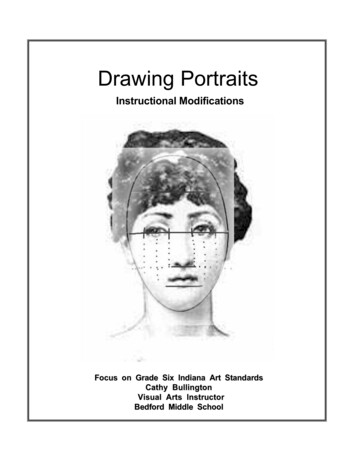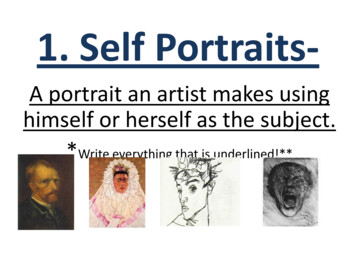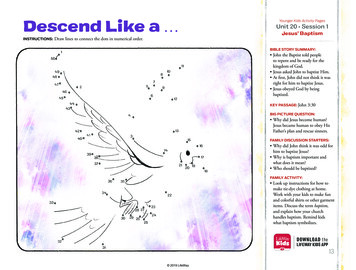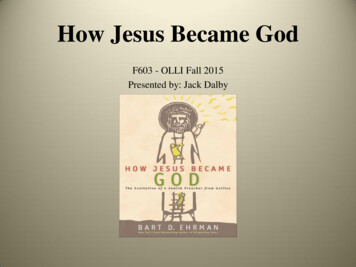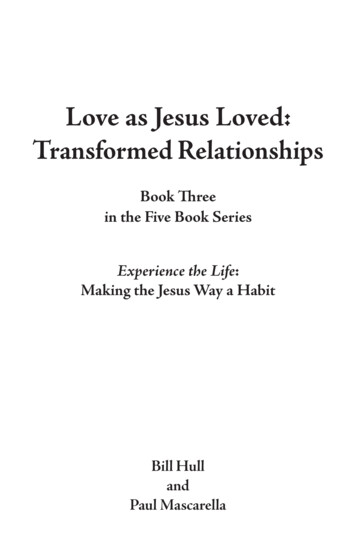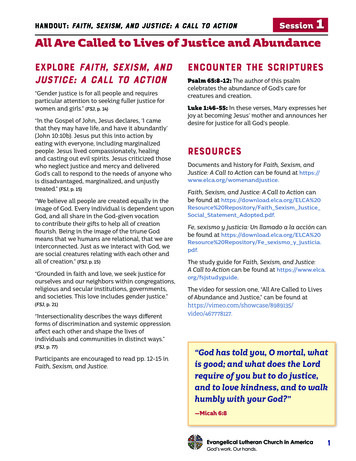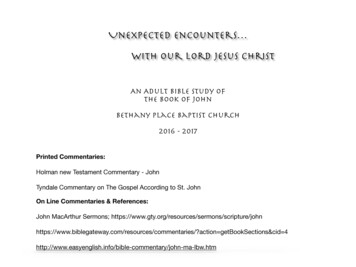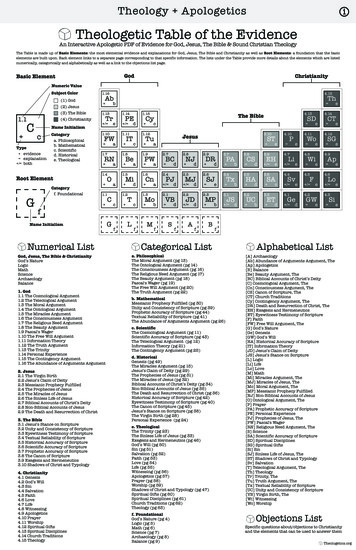
Transcription
Portraits of Jesus inJohn’s GospelPortraits of Jesus in John’s Gospel1
Portraits of Jesus inJohn’s GospelJohn—the beloved disciple of Jesus—writes so that people may believe that Jesus isthe Son of God (20:31). John is a Jesus lover. And Jesus loves John too. This mutuallove is seen in the way that John writes about Jesus. It’s as if he paints beautiful andendearing portraits of Jesus each able to stand alone for us to marvel at.As John reflects on Jesus, you are meant to also. Think of yourself at an art gallery.Stand back. Take it in. Get swept up into the scene. Think long and lovingly upon eachportrait as John paints it. Jesus will marvel you. He will leave an impression upon you.Each time you look at Jesus you will walk away in awe.A fellow admirer,J.Thomas HuttsPortraits of Jesus in John’s Gospel2
PortraitGalleryThe Gospel of John is broken up into different galleries. Each gallery shows you aunique aspect of Jesus’ life and ministry and mission. Within the Gospel of John thereare seven galleries.1—Jesus is God (1:1-28)2—Jesus is the God Man (1:29-4:45)3—Jesus Serves (4:46-12:50)4—Jesus Teaches (13:1-17:26)5—Jesus’ Passion (18:1-19:42)6—Jesus Lives (20:1-31)7—Jesus Gives Assurance (21:1-25)Page 4Page 6Page 15Page 23Page 28Page 31Page 34Desire to Dig Deeper?Questions are provided after each portrait for personal, family or small group benefit.Also, the footnotes provide additional Scripture for further discovery.Appendix A: 70 Portraits of Jesus in John’s GospelAppendix B: Jesus Sent by GodPortraits of Jesus in John’s GospelPage 36Page 393
Jesus isGodJesus is the Word (1:1-18).The Word has always been. He was there when it was only God and him. The Wordwas God. He was there when the world began. In fact, he created it all. The Word isthe One who spoke it all into existence. He gave it life. He lights the universe. He isthe light of men. John came to tell all about him so that all might believe through him(cf. 5:33-36).John knew his place and his part. John knew who was greater and it wasn’t him (cf.4:25-30). John was a pointer that pointed to the light that was coming.John wanted the world to see Jesus clearly and plainly. The world would not know himor receive him (cf. 5:41-46). But those who did believe would become children of God(17:25-26). Who is he? He is Jesus, the Son of God. He is God in the flesh. God withskin on. He is God, the Creator, who lived and dwelled among his creation. Jesus, thevisible God, helps us see what God, the invisible God, looks like. Jesus is God’s glory.What power do words have? What power does Jesus have being the Word?What proof is there that Jesus has always been?How does this image of Jesus as the Word encourage you?Portraits of Jesus in John’s Gospel4
Jesus is the Son of God (1:1-14; 20:31)1.John used this portrait of Jesus as Son more than any other in his Gospel. Justbecause Jesus is called the Son doesn’t make him any less than his Father. It’s afamilial title. It’s a title that shows the love of God. In it you see God’s heart for Jesus.Jesus helps you to understand who God is—what God is like. The Son helps you tosee the Father. Want to see God? Look at Jesus. The Son is visible, but the Father isinvisible. They are cut from the same cloth. They share the Great Throne. They areOne.How could Jesus being known as God’s Son be misunderstood?How does the Father Son relationship help you understand God and His love?How does Jesus help you see what God is like?Jesus is Grace and Truth (1:14; 1:17).Jesus is full of it. He is full of grace and truth. He speaks it, lives it, and defines it. Heshows what the grace of God and the truth of God is (cf. 18:37). What that is isexplained throughout the rest of John’s writing.The revealing of Jesus is God’s plan from the beginning so that the world myexperience grace and understand truth. He is the fulfillment of both. Grace and truthcame through Jesus.Why did God give Moses the Law? So that Jesus could show the essence of it. It is allpart of God’s master plan. Jesus authored it. Jesus is the centerpiece and focal pointof it all. Because God is at the center of it all.Who do you see grace and truth on display in Jesus’ life and ministry?How have you been impacted by the grace of God and truth from God?In what ways are you modeling grace and truth in your life?1Also see: 1:34, 49; 3:16-18; 10:36; 11:4, 27; 17:1; 19:7; 20:31Portraits of Jesus in John’s Gospel5
Jesus is theGod-ManJesus is the Lamb of God (1:29-36).Jesus as the Lamb is an image that points backward and forward. It points back in thatthe people in Jesus day would have remembered the story of Abraham when Godprovided a sheep to sacrifice in the place of his son (Genesis 22:8) and they would haveunderstood the sacrificial system when the priests yearly sacrificed for the sins of theirnation (Exodus 12:3; Isaiah 53:7).The Lamb also points forward to Jesus’ passion—his earthly mission. Jesus would bethe sacrificial Lamb. God would give his only son to atone for the sins of a nation andthe world once and for all (Acts 8:32; 1 Peter 1:19). It also points forward to Jesus’heavenly title (Revelation 5:6). We will forever remember Jesus as the Lamb slain forthe sins of the world.One could think of a lamb as a weak image, but how is it also a strong image for Jesus?How does Jesus being a lamb help us understand the plan of God?Jesus Ranks Highest Among Men (vs. 1:15, 27, 30).John the Baptist held some rank among men because he was a prophet, but even heknew that compared to Jesus he held a much lower rank. John said that he was noteven worth to untie Jesus’ sandal, which is like saying “I am lower than a slave next toJesus.”John humbly acknowledges that he was the one who announces Jesus’ arrival. That’sall. He was the loudspeaker who echoes out, “Jesus is here! Look at him!” Jesus alsoPortraits of Jesus in John’s Gospel6
pulls rank because was here before John and after him. Jesus has always been. Jesusis. And Jesus is the highest of all men.How does John express humility?Why is it important to see yourself compared to Jesus?In what ways does Jesus hold a higher rank than you?In what ways do you think or act like you hold a higher rank than Jesus?Jesus is Rabbi (1:38).2To be called a Rabbi is a term of respect or endearment or commitment. It means thatpeople—particularly his followers—consider him to be a teacher.Jesus is known for being a Good Teacher; a master teacher. He taught in synagogues(cf. 6:59; 18:20), but more often his classroom was mobile and in the midst of everydaylife. He taught crowds, small groups, and one-on-one. He taught in stories, proverbs,and sermons. Wherever he went he taught. His teachings caused most to wonder.As John’s Gospel unfolds many of Jesus’ wise teachings are recorded for us to learnfrom today. His Word still teaches.What is a memorable teaching of Jesus to you?What separates Jesus’ teaching for other teachers?What do you learn about teaching from Jesus?What is a lesson that Jesus has taught you?How can you remain teachable to the instructions and lessons of Jesus everyday?Jesus is the Messiah (1:41).3Messiah is a term that has a long history. The Jews long believed and were promisedthat a Messiah would come to deliver them (Is. 61:1). He would come from amongIsrael.The word Messiah has roots in the word to “massage” or “anoint”. Jesus is give thename the Anointed One, the Christ, the One who came to deliver the world.The Old Testament the idea of anointing was mainly for setting apart kings, but in theNew Testament the concept is applied to Jesus in a grander sense to include the idea ofan anointed prophet, priest and king.What does “Messiah” mean?How does the meaning add definition to who Jesus is?2cf. v.1:49; 3:2, 26; 6:25; 11:8; 14:5; 20:163cf. 4:25-26; 11:27; 12:34; 17:3; 20:31Portraits of Jesus in John’s Gospel7
How would you react if you were Andrew or Peter and you saw the promised Messiahfor the first time?How has Jesus delivered you?Jesus from Nazareth (1:45).Jesus had a hometown and roots. He was Nazarene (cf. 18:5-7; 19:19). Nazareth wasthe village where his earthly mother and father lived and where he grew up (Mt. 2:23).Often Jesus’ birth town, Bethlehem, gets more attention. Galilee, the region whereNazareth is located gets a bad rap for being a place where no prophet comes from.How much do you or others identify you by your hometown?How does Jesus being from a hometown show his human side?What do you know about Jesus’ ministry in his hometown?Jesus is King of Israel (1:49).4Israel thought their Messiah would be a king who would come from the line of David anddeliver them from the oppression of the Roman Empire. They were right. He did cometo restore the line of David, to deliver, to bring freedom from oppression, and toinaugurate his kingdom, but not in the way the Jews imagined.Israel really wanted Jesus to be their king (6:15). They brought him into Jerusalem onan unspoiled colt, shouted “Hosanna!” (12:13) He accepted the praise and glory, butthis was not his mission. An earthly king he is not.When Jesus was crucified the Romans mocked him by labeling him the King of theJews. Little did they know he was and is and will be. The emphasis is on ‘will be’.What was Nathanael thinking when he called Jesus “King”?What is Jesus king of and where is his kingdom?If Jesus’ inaugurated the kingdom on earth, when will it be consummated?What kind of king is Jesus? How is Jesus different than earthly kings?What is your response to King Jesus?Jesus is the Son of Man (1:51; 2:1-10).5The image of Jesus as King is future tense and so is Jesus as the Son of Man (Dan.7:13). Jesus used the term “Son of Man” of himself more than 80 times. It speaks of hishumanity and suffering and his work as “the ideal Man.”4cf. 12:12-15; 18:33-37; 19:2-22; Zeph. 3:15; Mt. 27:11, 42; Zech. 9:9; Heb. 2:85cf. 3:13-14; 6:27, 53, 62; 8:28; 12:23, 34; 13:31Portraits of Jesus in John’s Gospel8
On earth, Jesus was humble and unflashy—other than some of his miracles like turningwater into wine a a wedding and his transfiguration. However, Jesus said he wouldcome back in divine style. The clouds are his carpet and the sky his stairway. This isan image you have not see any man pull off, but Jesus is not an ordinary man. Think ofit as another episode like Jacob saw when angels from heaven ascended anddescended to earth, so Nathanael (and the others) would see Jesus do the same (Gen.28:12).Jesus is the one mediator between heaven and earth. Heaven is opened forcommunication with people.Why is it important to see the human side of Jesus?How does seeing Jesus as human help you to relate to Jesus?How is Jesus like no other man? How is Jesus the example human?What would it be like to see Jesus coming down from heaven?How does Jesus give you the ability to communicate to heaven?How does Jesus mediate your prayers?Jesus is the Sign of God’s Glory (2:1-11).6Jesus did many miracles. Turning water into wine at a wedding was his first public sign.Mary’s comments leave one to believe that she knew Jesus could do the miracle(2:3-5).Interestingly, John records the fewest amount of miracles compared to the othergospels,7 however John does so to reveal Jesus’ glory.Jesus’ signs often strengthen and solidified the faith of Jesus’ followers, but it wasn’t aguarantee. Sometimes people would ask Jesus to do signs (2:18), but not everyonebelieved even though Jesus did signs. In other words, signs don’t equal faith.Signs are insufficient for faith. Jesus didn’t do signs for the wow-factor just so peoplewould believe, but also to give proof that he was from God (20:30-31).What are some of Jesus’ most memorable signs and miracles?What importance did these signs have for Jesus’ ministry and glory?What connection or remembrance might the Cana miracle have with the Last Supper?(Lk. 22:20)How do Jesus’ miracles point to a Greater Miracle? (2 Cor. 5:17)What is the significance of cleansing in the context of this miracle and Jesus’ ministry?How does Jesus become the fulfillment for cultural and religious cleansing?6cf. 1:14; 2:18, 23; 3:2; 10:41; 11:40, 47; 12:28; 13:31-32, 38; 14:11-13; 17:1-26; 20:3072:1-11; 4:46-54; 5:1-15; 6:1-14, 15-21; 9:1-7; 11:1-44; 21:1-13Portraits of Jesus in John’s Gospel9
Jesus Knows Man and What’s in Man (2:24-25).You could say Jesus had X-ray vision. He could see through man’s skin to his heart.He knew all people and he kew what was in man. That makes him different than anyman because you cannot see inside a man like that.Jesus has supernatural knowledge of man.8 People asked Jesus to do many signs andwonders, but he knew their motivation and level of belief. 9 It is an amazing and fearfulthought to know that Jesus sees through you. The next two stories of Nicodemus andthe Samaritan Woman illustrate Jesus’ X-ray vision (see Ch. 3-4).What does Jesus know about man that you will never know about another man?What does Jesus know about you?How is the truth Jesus knows all about you both amazing and fearful?In what ways do you ask for a sign from God rather than just believing?What does Jesus know about your faith?Jesus is the Great Teacher (3:1-15).10Jesus loved to teach. It is part of his ministry. The way he taught was through anearthly story or illustration that has a heavenly or spiritual truth (3:31-34). Jesus’teachings often pointed back to Old Testament teachings and pointed forward toencourage his students to believe in him for eternal life.Jesus even taught teachers like Nicodemus. What Jesus taught Nicodemus was thedifference between physical birth and spiritual birth and Nicodemus’ need for the later.Not everything Jesus taught was caught. Only God could open eyes to understand andbelieve (9:30).Are there certain teachings of Jesus that have puzzled you?How do Jesus’ teachings go deeper than just an earthly truth?How does God give you understanding of Jesus’ teachings?Jesus is to be Lifted Up (3:14-15).11When Jesus referred to being “lifted up” he was talking about his death, particularly hisdeath on the cross. Moses lifted up a bronze snake on a pole as a cure for theHebrews disobedience (Num. 21:4-9). Moses was a symbol of Jesus who would belifted up on a cross for the disobedience and sin of mankind. Moses was a conduit of8cf. 4:16-19; 13:26-28; 16:19, 30; 17:6-26; 18:4; 1 Sam. 16:7; Ps. 139; Acts 1:249cf. 1:48; 5:42; 16:30; 6:14-15, 61, 64; Mt. 9:410cf. 11:28; 13:14; 18:20; 20:1611cf. 8:28; 12:32-34Portraits of Jesus in John’s Gospel10
God’s provision of life for the Jewish people, but Jesus was God’s ultimate provision ofeternal life for all people.What other OT symbols did Jesus come to fulfill?Why was it Jesus mission to live to die?Why is important that he knew this from the beginning of his ministry and that it wasn’tjust a last-minute add-on?How has Jesus’ death provided for your life?Jesus is the Love of God (3:16-21).Jesus shows the love of God. You get a good understanding of God’s love by looking atJesus.12Even when the world was in the shadow of darkness and loved sin more than the light,God gave Jesus, his Son. Jesus’ love is unconditional and sacrificial (3:16, cf. v.36). Itis because of Jesus’ most loving act—his death—that man is able to have eternal life.That is love. John’s main goal is that you would know it.13When you love someone, what do you often expect in return?How is it that God loves without strings attached?What amazes you about the love of God?How did Jesus demonstrate the love of God?What do you learn about the love of God through Jesus?How can you love like Jesus today?Jesus is the Bridegroom (3:29).Jesus on a few occasions talked about himself in a wedding metaphor as theBridegroom who would come for his Bride, the church (cf. Mt. 9:15; 22:1-14; 25:1-13). 14However, here John the Baptist refers to Jesus as the Bridegroom. John likens himselfto a friend who is filled with joy over Jesus’ growing influence.Jesus is coming for his Bride. Like the friend of the Bridegroom, John knows his role islimited simply to assisting Jesus. A friend of the Bridegroom is not greater than theGroom, just as a servant is not greater than his master.How is the wedding and Bridegroom illusion a joyful and celebratory one?How like John can you be full of joy over the Bridegroom?How does this portrait of Jesus culminate in Revelation 19:7-8?12cf. Rom. 5:8; Eph. 2:4; 2 Thes. 2:16; 1 John 3:1; 4:9-1013cf. 5:36, 38; 6:29, 57; 7:29; 8:42; 10:36; 11:42; 17:3, 23-26; 20:21;142 Cor. 11:2; Eph. 5:22–24; Rev. 21:2, 9; 22:17Portraits of Jesus in John’s Gospel11
Jesus is from Above and Above All (3:31).Jesus is in a category or stratosphere all to his own. Jesus is to be distinguished fromanyone whose origin is earthly. He cannot be assessed by earthly methods ormeasurements. Jesus is therefore utterly different than even John the Baptist. Jesusis supreme. He is head and shoulders above all other earthly messengers.Where was Jesus before he came into the world? (cf. 8:14; 13:3; 16:28)Why is it important to understand Jesus’ existence before coming to earth?How is Jesus in a category all to his own compared to all other men?What do you learn from John’s humility putting himself below Jesus?Why is it helpful to measure yourself against Jesus rather than another man?Jesus is Sent from God (3:34).15God not only sent mankind the message (his love letter), but also the Messenger (hislove in flesh). The image of Jesus being “sent” is a golden thread woven throughoutJohn’s Gospel. Now other image is repeated as often. Being sent from God affirmsJesus’ deity and heavenly origin, as well as God’s sovereignty and love.Where did the Father send Jesus from?What does it signify that Jesus was not only sent from God, but the “Sent One”?What role does Jesus play being sent from God?How has Jesus sent you into the world as his ambassadors with the same authority?(Mt. 28:19-20)Jesus is Given Authority (3:35-36).God the Father has entrusted all things to God the Son.16 Jesus has been given allauthority from heaven to accomplish all the Father’s purposes. The intimaterelationship between the Father and Son is sure. All that John asks is that you havefaith in Jesus. Accept Jesus and for you is promised eternal life, but reject Jesus andyou will face God’s wrath.Do you believe Jesus has authority from God?How you demonstrate your faith in Jesus’ authority?What authority does Jesus have in your life?cf. 3:17, 34; 4:34; 5:23-24, 30, 36-38; 6:29, 38-39, 44, 57; 7:16, 28-29; 8:16, 18, 26, 29, 42; 9:4; 10:36; 11:42;12:44-45, 49; 13:16, 20; 14:24; 15:21; 16:5; 17:3, 18, 21, 23, 25; 20:21; Gal. 4:4; 1 Jn. 4:9-10, 141516cf. 5:19, 22, 27, 30; 8:28; 12:49; 14:10; 17:2, 24; 19:11Portraits of Jesus in John’s Gospel12
Jesus is Living Water (4:10-15).17Water is life. Without water you die. Not only does water give life but it satisfies thirst.When Jesus says he will give the Samaritan woman living water he is talking abouthimself as the source of everlasting life. This statement made the woman think. Shedidn’t know who Jesus was or what he could give her. Jesus could give the womaneternal life and quench her deepest thirst. Jesus is a well that goes deeper that justphysical water.What cultural and spiritual barriers did Jesus have or break with the woman at the well?What kind of water was the woman really seeking and what did Jesus give to her?Why didn’t the woman understand what Jesus was saying? (4:15-26)How is Jesus your living water everyday and forever?Jesus is Prophet (4:19).18Prophets were sent from God to call the people to repent and turn back to God. Jesusdid this and more.Jesus knew things. He knew things about the future, but he also knew things about thepast and present that the ordinary man didn’t know. For example, he knew that thewoman at the well had many husbands.How did Jesus know these details? As a prophet, he had supernatural knowledge fromGod. He knew the details about man that could cut to the heart.What does Jesus know about the woman?What does Jesus know about you?As a prophet, how does Jesus call people to repent and turn back to Jesus?How was the woman’s response a common response toward prophets? (4:21-24)How has Jesus cut you to the heart?Jesus is Lord of the Harvest (4:34-38).The time between planting to harvest would take four months. To a human this mightseem long. When the harvest came there is no wonder it would be a time of immensejoy.Jesus often used agriculture to illustrate his mission and his Father’s plan. The harvestJesus talked about was not fruit or vegetable, but people. Jesus came to harvest souls.This was his mission. Jesus is both Sower and Reaper. He would sow seeds thatwould reap eternal life (Mt.13:37; Mk. 4:14). Now that’s immense joy!17cf. 7:37-38; 6:35-58; Jer. 2:13; 17:13; Is. 49:10; Rev. 7:1618cf. 1:21; 6:14; 7:16, 40; 9:17; 13:1-3; Mt. 21:11Portraits of Jesus in John’s Gospel13
What other teachings did Jesus give that used agriculture or sowing and reaping?Why is the harvest a happy time?19How joyful is the spiritual harvest—salvation?How does Jesus call you to be apart of the sowing and reaping and harvest? (Mt. 9:37;Lk. 10:2)Jesus is Savior of the World (4:42).20Just as John the Baptist said, “Behold, the Lamb of God who takes away the sins of theworld,” so the people of the Samaritan woman’s town believed that Jesus was reallywho she said Jesus was, “The Savior of the World.” In other words, the Samaritan’sascribed to Jesus the title Messiah or the Christ.Jesus brought salvation to the world. His light shines for all (1:9) and is not limited tothe nation Israel, but is for “every nation, tribe, people, and language” (Rev. 7:9).What does it mean that Jesus is Savior?How is Jesus not only the Savior of the Jews, but the world?How did Jesus bridge the spiritual gap between the Jews and Samaritans?What is your part in spreading the light that “Jesus saves” to the ends of the world?Why is it important to know that Jesus is the Savior for all nations, ethnicities, races,and language groups?19cf. 3:29; 8:56; 11:15; 14:28; 15:7; 16:20–22; 20:2020cf. 3:17; 12:47; (11:27); 17:6-23 1 Tim. 4:10; 1 Jn. 4:14Portraits of Jesus in John’s Gospel14
Jesus ServesJesus is Healer (4:46-54).Jesus healed people in high places of power and people in low places of poverty. Hehealed publicly and privately. Some people were thankful and some were unthankful.Some people asked Jesus to be healed and other times Jesus asked people if theywanted healing (cf. 5:1-17). Jesus often healed people with his touch, but in the case ofthe official’s son, Jesus healed with his words alone. Jesus didn’t even see the boyface-to-face, in fact, he was miles away.Often people, as in Galilee, came to Jesus as a healer rather than the Savior. StillJesus healed out of grace and love, but in this particular case he tested the faith of theofficial. Healing and faith didn’t always go together, but for the official it did. 21Why is faith that is built on signs and wonders incomplete faith?Why would some who followed Jesus just want healing minus faith?How is Jesus healer and Savior?What does healing tell you about the character of God and the mission of Jesus?Why is faith in Jesus absolutely necessary?How would you describe your faith in Jesus?Jesus is at Work (5:17).22Jesus had just healed a man who hadn’t walk for 38-years. You’d think the Jewishleaders would be amazed and acknowledge Jesus’ healing power coming from God.No, instead they are angered and found fault in Jesus healing on the Sabbath. AndJohn notes this as the reason for Jesus persecution (e.g. crucifixion; v.18).21cf. 2:18; 6:30; 20:2922cf. v.36; 14:11-13; 15:24; 17:4Portraits of Jesus in John’s Gospel15
When God rested on the seventh day (Gen. 2:2-3) from his work of Creation it was anexample for mankind to rest and remember God. Jesus makes the connection betweenhim and his Father in the continuous work of salvation and for his Sabbath healing.If God sustains the universe, makes life, heals, and judges, why is it not unlawful forJesus to do works of grace and mercy on the Sabbath. That’s what these leaders fail tounderstand. God and Jesus have the same mission: Jesus, as the One and Only Sonof God, claimed to be sent by God, on mission for God, doing the works of God,obedient to God, and bringing glory to God.Why were the Jewish leaders so angry with Jesus?How did Jesus’ claim of equality with God ultimately lead to his death?How does this this John 5:1-17 show you that Jesus is God and the he and God havethe same work or mission?What does the lame man’s response tell you about his faith or willingness to repent?Do you ever find yourself fault-finding like the Jewish leaders or ungrateful like thehealed man?Jesus Obeys (5:19-30).Jesus obeys the Father without question (cf. 18:11). Everything Jesus does he doesbecause the Father allows. The Father has given all authority and the right tojudgement to Jesus. This means that whoever believes in Jesus will have eternal life,but whoever rejects Jesus will be judged by him. Honor Jesus and you honor God.What do you learn about obedience from Jesus?What authority does Jesus have?What does it mean that Jesus is the judge of life and death?How do you mimic Jesus obedience?Jesus Bears the Testimony of God (5:32-46).Not only does God bear witness that Jesus is from God (cf. 8:18; Mt. 3:17), but theScriptures do too.23 When reading the Scriptures, it is clear that from Genesis toMalachi, Jesus is the Promised One.Even though there is all this proof that Jesus is who he says he is the people still do notreceive him or believe in him (v.43; cf. 1:11; 3:11, 32). That doesn’t make him any lessGod, it shows the hardness of man’s heart.How did God bear witness to Jesus being his Son?What proof is there in the OT Scriptures that Jesus is who he says he is?23cf. 12:41; 18:37; Num. 21:9; Deut. 18:15; Luke 16:31; 24:27Portraits of Jesus in John’s Gospel16
How did the Jews miss this about Jesus? (vs. 40, 43; ch. 3:19; 7:17; Mt. 23:37; Lk.13:34)How do you bear witness to the glory of God through your life and ministry?Jesus is the Bread of Life (6:32-58).Jesus had just turned a boys lunch into a meal for 5,000 people and had leftovers(6:1-15). In the past, God provided manna from heaven that preserved the life of Israelwhile in the Wilderness.The divine correlation is that God the Father provides again by sending Jesus who isthe promise of life to all who believe in him. As bread is essential to physical life, so ifJesus to eternal life.How does bread provide life for much of the world?How does Jesus provide life for the world?What connects does Jesus make between the bread he offers and the manna of Mosesday?Who have you shared this Bread with recently?Jesus is the Holy One (6:69).Peter, as a self-proclaimed spokesman for the disciples gave a confession of his faithand called Jesus the Holy One of God.24 He was convinced that Jesus’ words lead toeternal life.The title “Holy One of God” is unusual since a demon also used the same title of Jesus(Mark 1:24). It refers to Jesus’ transcendence, his representation of the Father (“ofGod”), and his Messiahship. In other words, Jesus was set apart from other men andwas connected to the Most Holy God. As the Holy One, Jesus was Israel hope andPeter was not about to abandon this hope, at least not yet.What is holiness?What did the demons know about Jesus that some people did not acknowledge?What was Jesus’ relationship with the Father? Why is this relationship so important?How is Peter’s story an ebb and flow of faith and doubt?How do you relate to Peter?Jesus Satisfies (7:37-39).Jesus calls people to come and drink. The timing was uniquely tied to the festival athand. During the Feast of Tabernacle there was a water ritual that reminded the people24cf. Mt. 16:16; Mark 8:29; Luke 9:20Portraits of Jesus in John’s Gospel17
of the water that God provided from the rock in the desert.25 In a desert, a river is life.Just like the woman at the well (4:10), Jesus on the last and biggest day of the feastoffers the crowd water from the spring of eternal life, namely his Spirit (cf. 4:14;6:53-56).Have you every been really thirsty?How is thirst a fitting picture for our spiritual condition?Why is Jesus the only thirst quencher that truly satisfies?When did Jesus promise a helper would come?How does the Holy Spirit bring new life?Jesus is the Defender of the Condemned (8:3-11).A women had been caught in the act of adultery and she is brought before Jesus by thereligious leaders. They do it to test (or trap) Jesus’ understanding of the law (againstRoman law).26What an embarrassing and shameful situation for the women. It is true that her sincondemns her. Yet the religious leaders compound the condemnation by making apublic spectacle of the situation.Jesus, the author and perfecter of the law, flips situation (from legal to moral) upon thereligious leaders to cast the first stone (Deut. 17:7). Jesus defends the woman, showsher deep compassion, yet doesn’t condone her sin by telling her to sin no more (cf.3:17).How does the law naturally condemn you?Why is there no condemnation when you are in Christ?What do you learn from Jesus about judging sin and showing compassion to others?What comfort do you have that Jesus came to your defense when you blew it andsinned?Jesus is the Light of the World (8:12; 9:4-5; 11:9).27Light reveals what is hidden in darkness. Light also makes the way or path to lifevisible. Jesus is that true light. He both reveals sin and makes the way of eternal lifevisible.2825cf. Num. 20:8-11; Ps. 78:15-16; Is. 12:3; 55:1; 58:11; Zech. 14:8, 16-19; Ezk. 47:1-11; Rev. 22:1-226cf. Mt. 16:1; 19:3; 22:18, 35; Mark 8:11; 10:2; 12:15; Luke 10:25; 1127cf. 1:4-5, 9; 3:19-21; 12:35-36, 46; Ps. 36:9; Isa. 42:6; 49:6; Mal. 4:228e.g. Ps 27:1; Isa 58:8; cf. John 1:5; Acts 26:18; 2 Cor 4:4–6; Eph 5:14; 1 John 1:7Portraits of Jesus in John’s Gospel18
Jesus’ claim to be the light of the world wa
Portraits of Jesus in John’s Gospel 6 Jesus is the God-Man. pulls rank because was here before John and after him. Jesus has always been. Jesus is. And Jesus is the highest of all men. . the Christ, the One who came to deliver the world. The Old Testament the idea of
